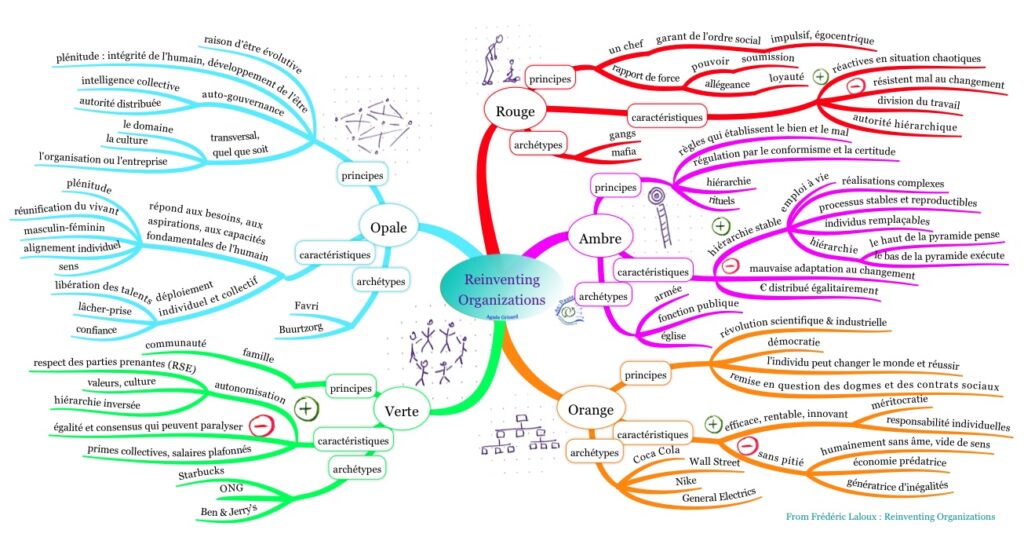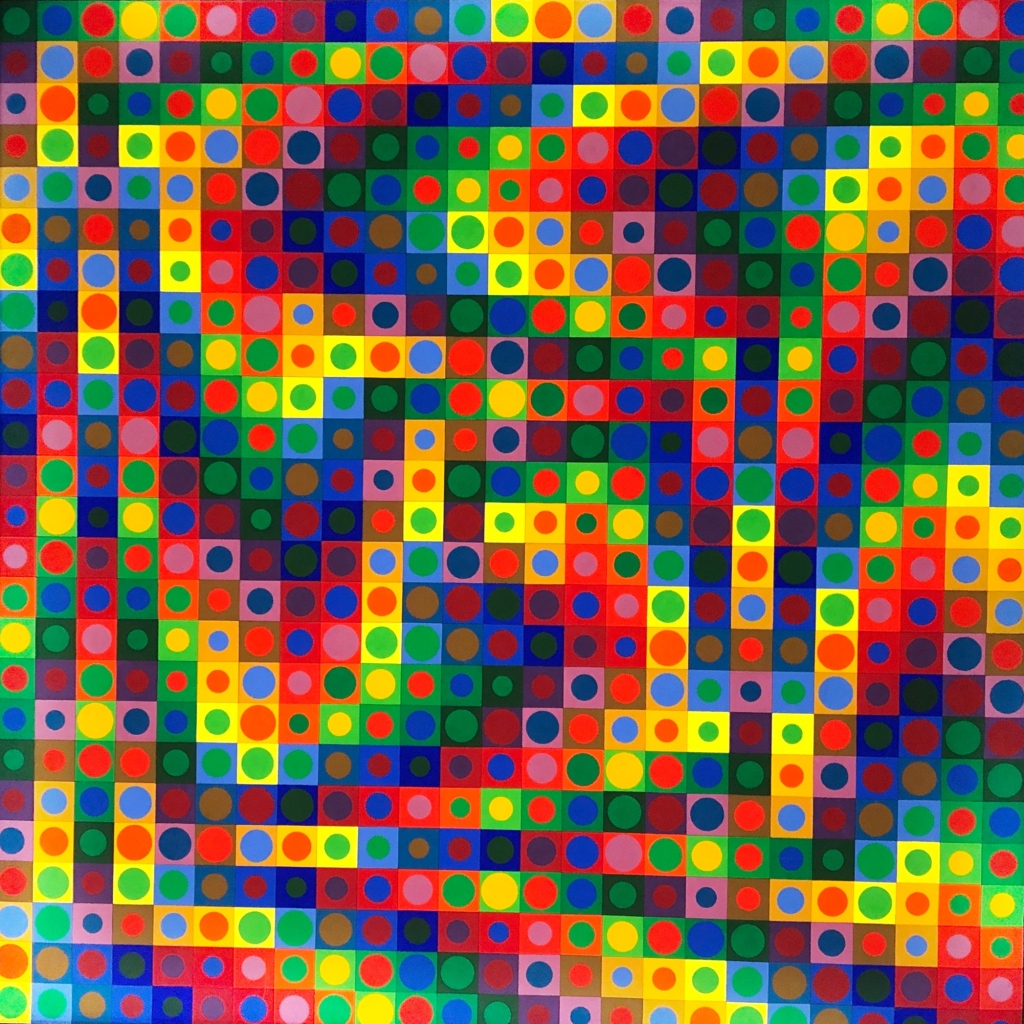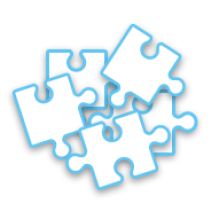Article en français ci-dessous
How does our brain work? Are there specific operating modes that characterize our behaviors, what we feel, and what we think?
Between two people who are laughing, are there similarities in how their brains function?
Comment fonctionne notre cerveau ? Y a-t-il des modes de fonctionnements particuliers qui caractérisent nos comportements, ce que nous ressentons et ce que nous pensons ?
Entre deux personnes en train de rire, y a-t-il des similitudes de fonctionnement cérébral ?

Our brain works by activating connections between neurons, which transmit information through this incredibly dense and complex network. In practical terms, a lot of information is sent to different parts of our brain.
Today, we know that certain areas are specialized for specific functions, such as speaking, feeling fear, memorizing, playing the violin, singing, and so on.
We also know that the brain evolves throughout our lives—a concept referred to as brain plasticity.
At the same time, these areas don’t function separately, one after the other, or as independent systems operating side by side. That said, when we feel fear, for example, one particular region of the brain becomes especially active. And it’s the same region for two different individuals experiencing fear, regardless of their culture, language, or background. To describe this way of functioning, we use the term Brain Governance.
What is Governance?
It’s a bit like a jazz or traditional music orchestra: all the musicians play a theme together, in the same rhythm, following the same harmony.
At some point, one instrument starts a solo—say, the saxophone. Often, the saxophonist stands up, and above all, you hear this instrument rise above the others. The other instruments keep playing, providing accompaniment, but at that moment, the saxophone stands out more prominently. And during that time, the saxophone “leads the dance”: it sets the tempo, can shift the harmony, or even change the theme, improvising while the others follow its lead. It’s the one in charge.
Then, it takes its place again, and a little later, it’s the double bass’s turn to solo, and so on. The governance shifts between them.
Our brain operates in a similar way.
At certain moments, when we feel fear, for instance, our brain switches to an instinctive governance mode. Then, once the situation changes, we might feel relaxed and full of imagination. That’s another type of governance at work—in this case, adaptive governance.
The Neurocognitive and Behavioral Approach, developed by the IME (Institute of Environmental Medicine), identifies four types of governance:
- Instinctive Governance, which governs behaviors, thoughts, and emotions tied to individual survival. It’s the seat of calmness as well as various forms of stress: flight, fight, freeze.
- Gregarious Governance, which governs the individual within a group. It shapes how we take our place in a group naturally or by default.
- Emotional Governance, a sort of hard drive for our brain. It’s the seat of our personality traits, values, and everything we memorize.
- Adaptive Governance, the seat of our intuition, innovation, and creativity. Like a control tower, it remains vigilant at all times.
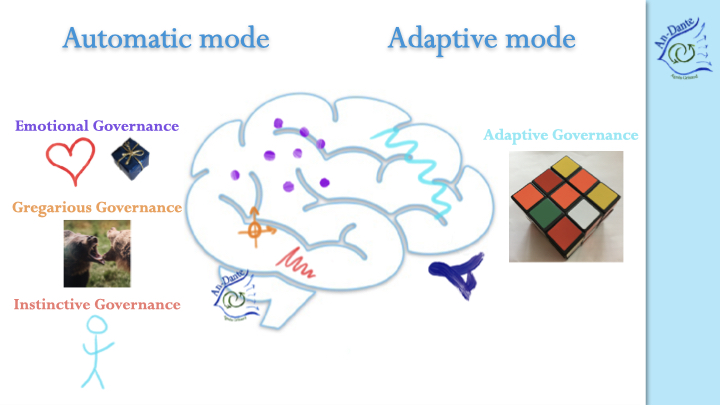
That said, our brain exhibits a kind of functional heterogeneity: the instinctive, gregarious, and emotional governances are automatic, meaning they activate on their own.
For example, when we’re stressed, we don’t decide to be—it just happens, and we can only observe it.
The adaptive governance, on the other hand, isn’t automatic. It can only take over if the other governances “hand over control” to it. For instance, if I’m stressed, I can’t access my intuition. I first need to return to a calm state to switch.
Thus, we need to learn to consciously shift from the automatic mental mode to the adaptive mental mode. This is also what’s referred to as stepping back or gaining perspective.
The Behavioral Dynamics Profile provides an indication of our ability to shift into this adaptive mental mode.
This capacity can be developed, partly through education and partly through training exercises.
Notre cerveau fonctionne en activant les connexions entre les neurones, qui transmettent des informations, à travers ce réseau très dense et complexe. Concrètement, de nombreuses informations sont transmises à différents endroits de notre cerveau.
On sait aujourd’hui que certains territoires sont spécialisés dans certaines fonctions, comme par exemple le fait de parler, ou encore d’avoir peur, de mémoriser, de jouer du violon, de chanter…
On sait également, que le cerveau est en évolution tout au long de la vie, on parle alors de plasticité cérébrale.
En même temps, ces territoires ne fonctionnent pas séparément, l’un après l’autre, ou comme des systèmes indépendants, côté à côte. Cela dit, lorsque nous avons peur par exemple, une zone du cerveau est plus particulièrement active. Et c’est la même zone pour deux individus différents qui ont peur, cela quelles que soient leur culture, langue ou origine. Pour caractériser ce fonctionnement, on parle de Gouvernance cérébrale.
Qu’est-ce que la Gouvernance ?
C’est un peu comme pour un orchestre de Jazz ou de musique traditionnelle : les instrumentistes jouent tous ensemble un thème, au même rythme, sur la même harmonie.
A un moment, l’un des instruments démarre un solo. Par exemple le saxo. Alors souvent le saxophoniste se lève, et surtout on entend son instrument qui « passe au dessus » des autres. Les autres instruments continuent à jouer, à accompagner, et, en même temps, on entend plus particulièrement le saxo. Et à ce moment-là, c’est lui qui « mène la danse » : il choisit le tempo, il peut changer l’harmonie, voire même le thème, il réalise des improvisations et les autres lui emboitent le pas. C’est lui qui gouverne.
Puis, il reprend sa place et un peu plus tard, c’est le solo de la contrebasse, et ainsi de suite. Les gouvernances alternent.
Finalement pour notre cerveau, c’est un peu pareil.
A certains moments, nous ressentons de la peur par exemple, notre cerveau passe en gouvernance instinctive, et puis lorsque la situation a évolué, nous nous sentons détendus et pleins d’imagination. C’est une autre gouvernance qui est à l’oeuvre, dans cet exemple, la gouvernance adaptative.
L’Approche Neurocognitive et Comportementale développée par l’IME (Institut de Médecine Environnementale) distingue quatre type de gouvernances :
- La gouvernance instinctive qui régit les comportements, pensées et émotions liées à la survie de l’individu, elle est le siège du calme et des différentes formes de stress : fuite, lutte, inhibition.
- La gouvernance grégaire qui régit l’individu dans le groupe, elle est à l’origine de la façon dont nous prenons notre place dans un groupe, spontanément, par défaut.
- La gouvernance émotionnelle, sorte de disque dur de notre cerveau, elle est le siège de nos traits de personnalité, de nos valeurs, et de tout ce que nous mémorisons.
- La gouvernance adaptative, siège de notre intuition, de notre capacité d’innovation et de créativité. Comme une tour de contrôle, elle est vigilante en permanence.
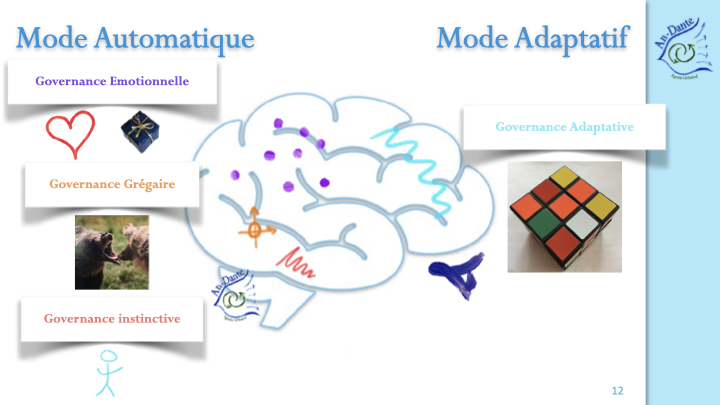
Cela dit, notre cerveau présente une sorte d’hétérogénéité de fonctionnement : les gouvernances instinctive, grégaire et émotionnelle sont automatiques, c’est à dire qu’elles se déclenchent toutes seules.
Par exemple, quand nous sommes stressés, nous ne l’avons pas décidé, nous pouvons juste le constater.
La gouvernance adaptative, elle, n’est pas automatique. Elle ne peut gouverner que si les autres gouvernances lui « passent la main ». Par exemple, si je suis stressée, alors je n’accède pas à mon intuition. je dois d’abord revenir au calme pour basculer.
Il nous faut ainsi apprendre à basculer consciemment du mode mental automatique au mode mental adaptatif. C’est aussi ce que l’on nomme la prise de recul.
Le Profil de dynamique comportementale donne une indication de notre capacité à basculer en mode mental adaptatif.
Cette capacité se développe, d’une part par l’éducation, d’autre part via des exercices d’entrainement.





